Voxx Electronics DEI6213 IVU User Manual
DEI Headquarters, Inc. IVU
User Manual
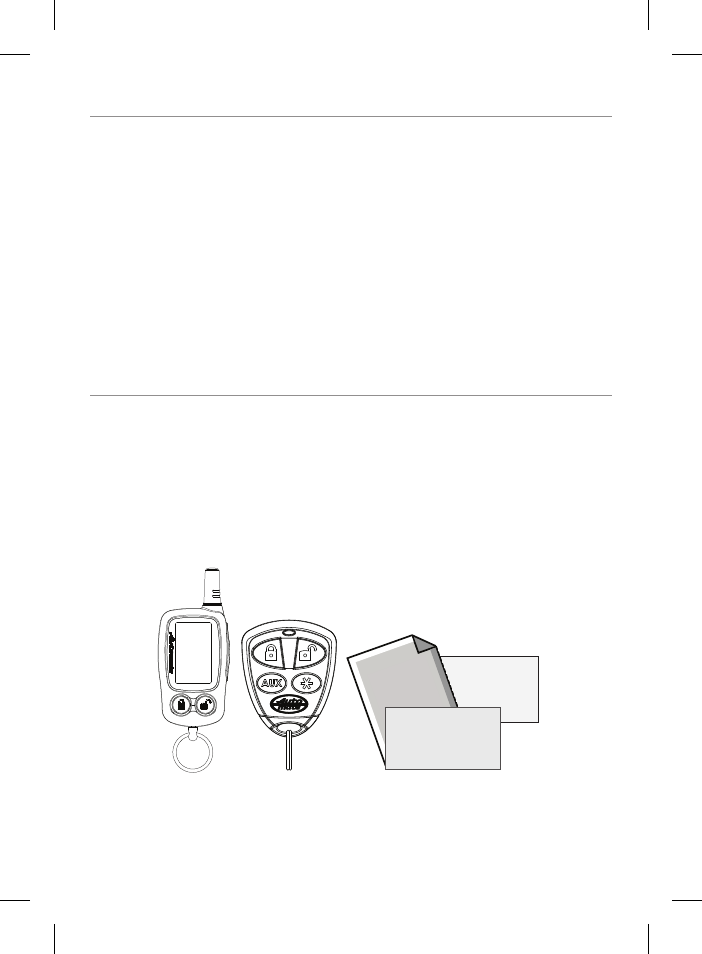
i
© 2010 Directed Electronics. All rights reserved.
Congratulations
Congratulations on the purchase of your state-of-the-art security/keyless
and remote start system. Reading this Owner’s Guide prior to using your
system will help maximize the use of your system and its many features.
For more information please visit us online at:
www.automatecarsecurity.com.
For any additional questions please contact your authorized Directed
dealer or Directed at
1-800-753-0600.
Additional support is also
available at:
http://support.directed.com
What’s included
• One 5-button 2-way LCD remote control
• One 4-button 1-way remote control
• Your warranty registration
• Quick reference card
• This owner's guide
Warranty
Card
Owner’s
Guide
Quick
Reference Card

Important information
Government Regulations and Safety information
Read the Government Regulations and Warning! Safety
First sections of this manual prior to operating this system.
Warning!
Failure to heed this information can result in
death, personal injury or property damage and may also
result in the illegal use of the system beyond its intended
purpose.
Your warranty
Your system comes with a warranty. Please make sure you receive
the warranty registration card and proof of purchase from your dealer
indicating the product was installed by an authorized Directed dealer.
Your product warranty must be validated within 10 days of purchase.
You can validate online at: www.prodregister.com/automate or com-
plete and return the warranty registration card.
Replacement Remote controls
If additional remote controls are desired, please see your authorized
dealer or visit us at www.directedstore.com to order. Your 2way re-
placement part number is 477A. Your 1-way part number is 474A.

1
© 2010 Directed Electronics. All rights reserved.
Contents
Congratulations .................................................................................................i
What’s included .................................................................................................i
Important information ........................................................................................ii
Your warranty...........................................................................................ii
Replacement Remote controls .....................................................................ii
Getting Started .................................................................................................3
System maintenance ..................................................................................3
Battery Replacement ..................................................................................3
LCD 2-way Remote Control .................................................................................4
Control Center ..........................................................................................5
Display icons............................................................................................6
Basic Commands ..............................................................................................8
Arm/lock .................................................................................................8
Disarm/unlock..........................................................................................8
AUX ........................................................................................................8
Remote start .............................................................................................9
LCD backlighting ......................................................................................9
Advanced Commands .....................................................................................10
Additional auxiliary functions. ..................................................................10
Timer mode ............................................................................................10
Short-run turbo mode ...............................................................................10
Optional rear window defogger ...............................................................10
Temperature Start mode ...........................................................................11
Internal temperature ................................................................................11
Time/alarm clock ....................................................................................11
Parking timer ..........................................................................................11
Beep/vibrate notification .........................................................................12
Power Save ............................................................................................12
Remote operation ............................................................................................13
Paging features ......................................................................................13
Setting the clock .....................................................................................13
Remote and System operations .........................................................................14
Passive arming/locking ...........................................................................14
Warn away® response (security only) ........................................................14
Triggered response (security only) ............................................................15
Multi-level security arming (security only)....................................................16
Arming while driving (security only) ..........................................................16
High security disarm (security only) ...........................................................16
System Override .....................................................................................16
Valet mode ............................................................................................17
Remote start ...........................................................................................18

2© 2010 Directed Electronics. All rights reserved.
Valet take-over ........................................................................................20
Power saver mode ..........................................................................................20
Diagnostics (security only) ................................................................................21
Arming diagnostics .................................................................................21
Disarming diagnostics .............................................................................21
Government Regulations ..................................................................................23
Warning! Safety First .......................................................................................24
Caution .................................................................................................25
Patent Information ...........................................................................................26
Español .........................................................................................................28

3
© 2010 Directed Electronics. All rights reserved.
Getting Started
System maintenance
The system requires no specific maintenance beyond battery replace-
ment for the remote controls. The 2-way remote control is powered by
a 1.5V AAA battery. The LCD displays a battery level indicator which
has three bars indicating the current charge level of the battery. When
the battery reaches a low charge level that requires replacement, the
remote control generates a single notification sound, and the battery
level indicator flashes continuously.
Your 1-way remote control is powered by a coin cell battery (CR-2032)
that can be purchased at most retailers. The operating range diminishes
as the battery weakens.
Battery Replacement
Gently slide the battery cover release tab to unlatch the battery com-
partment (located on back of remote control), then slide the door down
to expose the battery and remove the expired battery. Place the new
battery into the remote verifying the correct polarity. When power is re-
turned, all LCD icons are displayed, and the remote plays a melody.
1-way battery replacement
Locate the small slot on the side of the remote control. Insert a small
slotted screwdriver or equivalent tool into slot and pry the case apart.
Replace battery while verifying the correct polarity and then snap case
together.
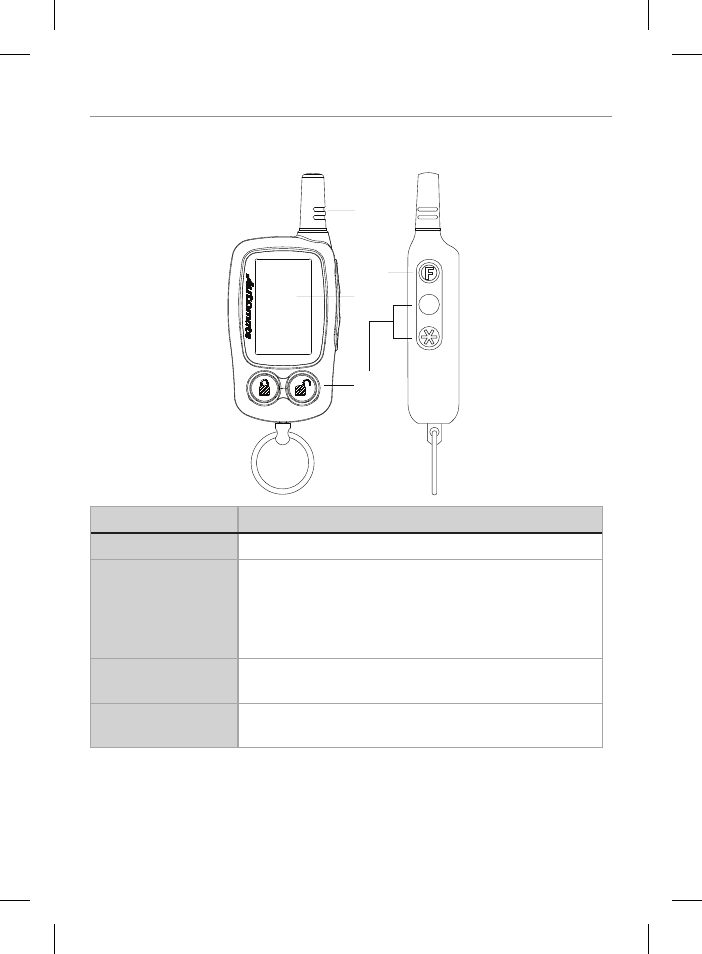
4© 2010 Directed Electronics. All rights reserved.
LCD 2-way Remote Control
AUX
Front View Side View
Command
Buttons
Function
Button
Display
Antenna
Feature Description
Internal Antenna Used for transmitting and receiving information
Display Text field - the upper portion of display - shows the Clock,
Remote Start Runtime or Temperature.
Status screen - the lower portion of the display contains status
icons for the System, Siren/horn, Alarm zones, Remote Start
and Remote Control.
Command buttons (4) Used to perform arming/locking, disarming/unlocking, aux-
iliary channel and remote start commands
Function button Used to turn on backlight or access adjustment mode and
advanced commands

5
© 2010 Directed Electronics. All rights reserved.
Control Center
Button
LED
Antenna
The Control Center, typically located on the upper part of the front
windshield sends and receives commands or messages to and from
your system. It consists of:
• The In-vehicle system antenna: for 2 way communication.
• The control center LED: a visual indicator of the system’s status.
• The control center button: for placing the system into Valet Mode*
and to perform the Emergency Override* operation.
* See Remote and System Operations section for details.
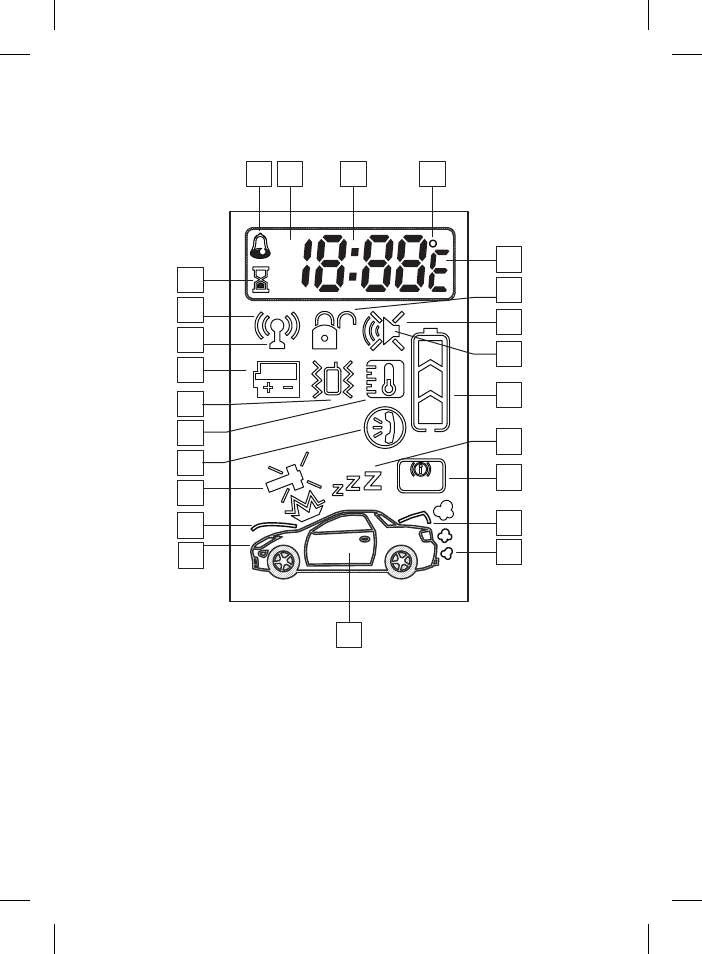
6© 2010 Directed Electronics. All rights reserved.
Display icons
AM
PM
INHIBIT
SAVE
A
1
234
5
6
7
8
9
10
11
12
13
16
17
18
19
20
22
21
23
24
15
14

7
© 2010 Directed Electronics. All rights reserved.
Item Description
1 Vehicle Interior Temperature Indicator
2 Numeric Display
3 AM/PM Indicator
4 Alarm Clock Mode Indicator
5 Timer Function Indicator
6 Transmission Indication
7 Transmit Range Indicator
8 Power Saver Mode Indicator
9 Vibrate/Beep Mode Indicator
10 Temperature-Controlled Remote Start Indicator
11 Vehicle Page Mode Indicator
12 Full Trigger Shock Sensor Indicator
13 Hood/Trunk Open or Trigger Indicator
14 Parking Light Indicator
15 Door Open or Trigger Indicator
16 Remote Start Indicator
17 Hood/Trunk Open or Trigger Indicator
18 Remote Start Safety Shutdown Indicator
19 Valet Mode Indicator
20 Battery Level Indicator
21 Full Trigger Alert Indicator
22 Silent Arm/lock/Disarm/unlock Mode Indicator
23 Arm/lock/Disarm/unlock Indicator
24 Celsius/Fahrenheit Indicator

8© 2010 Directed Electronics. All rights reserved.
Basic Commands
Note: Button configuration also applies to the 1- way remote control.
Arm/lock
Press
and release
The alarm arms, doors lock (if connected), and the siren/horn sounds
and parking lights flash once. If Valet mode* is On, the doors lock and
the arm/lock indicator** is displayed. Exit Valet mode to arm/lock the
alarm normally.
To Arm/lock and Panic
Press
and
hold
The alarm Arms (or Locks in Valet) and, after 2 seconds, sounds the
siren/horn and flashes the parking lights.
Disarm/unlock
Press
and release
The alarm disarms, doors unlock (if connected), and the siren/horn
sounds and parking lights flash twice. Turns panic off if on. If Valet
mode* is On, the doors unlock and the disarm/unlock indicator** is
displayed.
AUX
Press
and release
Perform before the Arm/lock or Disarm/unlock command to use the
remote control in Silent Mode™.
For optional function (trunk release)
Press
and
hold
Activates the Aux output, such as trunk release or an expansion
function that you have added to your system. The auxiliary output

9
© 2010 Directed Electronics. All rights reserved.
controls: .
Remote start
Press
and release
Activates (or if On, deactivates) the remote starter. The engine and
parking lights turn On.
LCD backlighting
Press
and release **
LCD backlighting turns on.
To enter adjustment mode
Press
and
hold
When held for more than five seconds the remote enters adjust-
ment mode allowing the setting of the clock, timer mode, and
audible melody selection. For more information, see
Advanced
Commands
section or refer to the expanded version of this manual
online at www.automatecarsecurity.com.
* See Remote and System Operations for details.
** 2-way remote control only
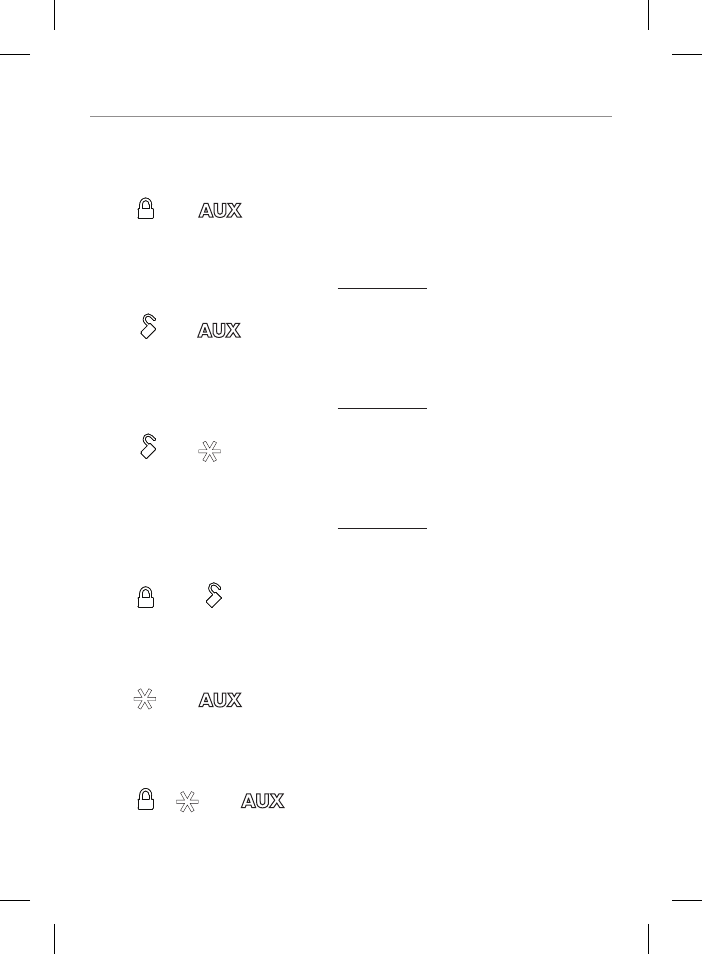
10 © 2010 Directed Electronics. All rights reserved.
Advanced Commands
Note: Button configuration also applies to the 1- way remote control.
Additional auxiliary functions.
Press
and buttons simultaneously
Activates an optional auxiliary convenience or expansion function that
you have added to your system.
The auxiliary output controls
Press
and buttons simultaneously
Activates an optional auxiliary convenience or expansion function that
you have added to your system.
The auxiliary output controls
Press
and buttons simultaneously
Activates an optional auxiliary convenience or expansion function that
you have added to your system.
The auxiliary output controls
Timer mode
Press
and
buttons simultaneously
Activates timer mode.
Short-run turbo mode
Press
and buttons simultaneously
Activates short-run timer mode.
Optional rear window defogger
Press
, and buttons simultaneously
Activates the optional Rear window defogger. The parking lights flash
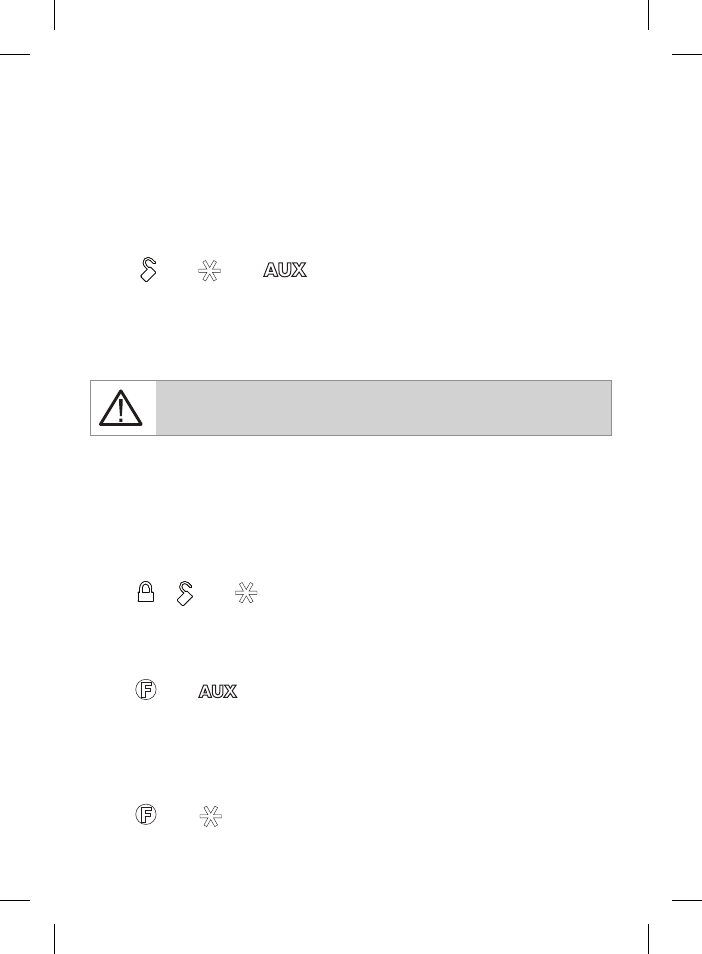
11
© 2010 Directed Electronics. All rights reserved.
two times and the rear defogger is no longer active when the vehicle
is remote started. When the same procedure is repeated, the defogger
activates and the parking lights flash three times. If the vehicle interior
temperature is greater than 55°F when the remote start is activated, the
rear defogger does not turn on.
Temperature Start mode
Press
and and buttons simultaneously
Activates the Temperature Start mode. The parking lights flash fast four
times to confirm activation. The engine does not start once activated, it
starts when the vehicle interior temperature drops below 0°F.
Warning!
Car should be parked in a well ventilated area
when using this feature.
Deactivate Temperature Start mode by pressing the same buttons again
or turning the vehicle ignition on. The parking lights flash slowly four
times to confirm deactivation.
Internal temperature
Press
,
and buttons simultaneously (2-way only)
Displays the internal temperature of the vehicle on the LCD.
Time/alarm clock
Press
and buttons simultaneously (2-way only)
The numeric display toggles between the time of the day and the alarm
clock when these buttons are pressed simultaneously.
Parking timer
Press
and buttons simultaneously (2-way only)

12 © 2010 Directed Electronics. All rights reserved.
Activates the parking timer. Each additional press toggles through the
available options (10 min., 20 min., 30 min., 1 hour, 1.5 hours, 2
hours, and off).
Beep/vibrate notification
Press
and
buttons simultaneously (2-way only)
Toggles between beep notification and vibrate notification.
Power Save
Press
and buttons simultaneously (2-way only)
Activates battery saver mode. Reduces power consumption on the
remote control battery when the alarm is inactive or disarmed/un-
locked.

13
© 2010 Directed Electronics. All rights reserved.
Remote operation
The remote start system operates at 434 MHz and incorporates Direct-
ed’s proprietary A.S.K. out-board two-way remote. The high frequency
combined with Binary Data communication achieves superior range
with two-way communication.
Paging features
The control module sends a page to the remote as confirmation of a
received command, or alarm system status.
When the remote receives a page notification, it beeps or vibrates and
the alarm status, armed/locked or disarmed/unlocked, (the lock or un-
lock icon) appears on the LCD. If the alarm has been triggered, the
remote LCD displays the zone triggered. To clear the alarm page, press
any button on the remote. The LCD information is also cleared.
Note: You will not be able to send a command, until the alarm page
is cleared.
Setting the clock
To set the clock
press
and
hold
for five seconds, the transceiver
will sound twice and the hour selection will start flashing. Immediately
press
to advance the hour selection or to reverse the hour
selection.
Once the correct hour is displayed
press
again and the minute
selection will start flashing. Then
press
to advance the minute
selection or to reverse the minute selection. Once the correct time
is displayed simply stop pressing all buttons for 15 seconds and the
transceiver will automatically exit the clock mode.

14 © 2010 Directed Electronics. All rights reserved.
Remote and System operations
Passive arming/locking
The system can be programmed to arm/lock itself au to mat i cal ly (called
pas sive arming/locking). If the system is programmed for passive arming/
locking, it will automatically arm/lock 30 seconds after the ignition is
turned off and the system detects that you have left the vehicle by opening
and closing a door. Whenever the system is in its 30-sec ond passive arm-
ing/locking count down, the status LED will flash twice as fast as it does
when the system is armed/locked. At the 20-second point of the count-
down, the siren/horn will sound to indicate that the system is about to
arm/lock. At the 30-second point, the parking lights will flash to indicate
that the system is armed/locked.
Note: If any protected entry point (such as a door or a switch-protected
trunk or hood) is open, the system will not passively arm/lock (unless
forced passive arming/locking is programmed on). See Programming
Options section in the expanded version of this manual online at www.
automatecarsecurity.com..
Warn away® response (security only)
A Warn Away Response consists of an alarm page along with the
responses described below.
• Shock Sensor - Light impacts to the vehicle will flash the vehicle
lights and sound the siren/horn for a few seconds.
• Remote Control Notification - Ten quick beeps (or one vibration).
• The remote will enter Page Recognition Mode and operate alarm
page alerts.
Note: Icons 12 and 13 represent alarm system zone inputs. For more

15
© 2010 Directed Electronics. All rights reserved.
information about icons and the zones they represent refer to the Button
Configuration and Icons description section in the expanded version of
this manual online at www.automatecarsecurity.com.
Triggered response (security only)
A Triggered Response can be activated by any of the triggers listed be-
low and consists of an alarm page along with the response described
for each trigger. The default Triggered Response duration is 30 seconds
but can be programmed from 1-180 seconds by your installer.
• Shock Sensor Trigger - Heavy impacts to the vehicle will instantly
sound the siren/horn and flash the lights for the programmed dura-
tion and report Zone 2.
• Door Trigger - If a door is opened the siren/horn will sound and
lights flash for three seconds, then the siren/horn will sound con-
tinuously and the lights will flash for the programmed duration and
report Zone 3. The three seconds allow the user time to disarm/
unlock the system with a minimum of noise should a door be
opened inadvertently while the system is armed/locked.
• Hood Trigger - Opening the hood will sound the siren/horn, flash
the lights for the programmed duration, and report Zone 1.
• Trunk Trigger - Opening the trunk (if connected) will instantly sound
the siren/horn and flash the lights for the programmed duration
and report Zone 4.
• Ignition Trigger - Turning on the ignition key will trip the same pro-
gressive re sponse as the door trigger and report Zone 5.
When a Triggered Response is activated the 2-way remote control
will:
• Repeat four quick beeps (or vibrate) for 15 seconds.

16 © 2010 Directed Electronics. All rights reserved.
• The full trigger alert icon (28) will turn on for 15 seconds.
Multi-level security arming (security only)
Multi-Level Security Arming allows you to select which of the system’s
inputs or sensors will be active and which will be bypassed when the
system is armed. For more information, please refer to the expanded
version of this manual online at www.automatecarsecurity.com
Arming while driving (security only)
Your security system can be armed while driving the vehicle.
Press on the remote control for two seconds while the vehicle is
running. The siren/horn will sound once to indicate that the security
system is armed, and then once more to indicate that the ig ni tion is on.
The system will not respond to any input except the door triggers, and
the starter kill relay (if installed) will not be activated. Once you have
arrived at your des ti na tion, the system will disarm when the ignition is
turned off. The siren/horn will sound twice and the LED will then stop
flashing. The system can also be disarmed at any time by pressing
High security disarm (security only)
This security system offers High Security Disarm. High Security Disarm
is a feature that makes it possible to silence and reset the system while
it is triggering, without disarming the system. For more information,
please refer to the expanded version of this manual online at www.
automatecarsecurity.com
System Override
If your remote control is lost or damaged, you can manually disarm your
vehicle security system or disable an optional starter kill. To disarm or
disable the system without a remote control, you must have the vehicle’s
ignition key.

17
© 2010 Directed Electronics. All rights reserved.
To disarm/disable the system:
1. Turn the ignition to the ON position.
2. Press the control center button the preset number of times (one to
five times) within15 seconds (the factory default setting is 1 press).
After five seconds, the sys tem will disarm/disable. If the system
does not disarm/disable, you may have waited too long. Start
over by turning the ignition off and on.
Number of Presses_____________________________________
Important:
The control center button can be programmed to
respond to 1-5 presses for the disarm/disable function. You
must check with the installer to verify the programming for your
individual unit.
Valet mode
You can prevent your system from automatically arming/locking and
trig ger ing by using Valet Mode. This is very useful when washing the
ve hi cle or having it serviced. In Valet Mode, the system/starter kill will
not arm/enable, even with the remote control, but all convenience func-
tions (door locks, trunk re lease, etc.) will continue to work nor mal ly.
To enter or exit Valet Mode:
1. Turn the ignition on.
2. Turn the ignition off.
3. Press and release the control center button within 10 seconds.
To enter or exit Valet Mode using the remote control:
4. Open any vehicle door.
5. Press .
6. Press and then press again.
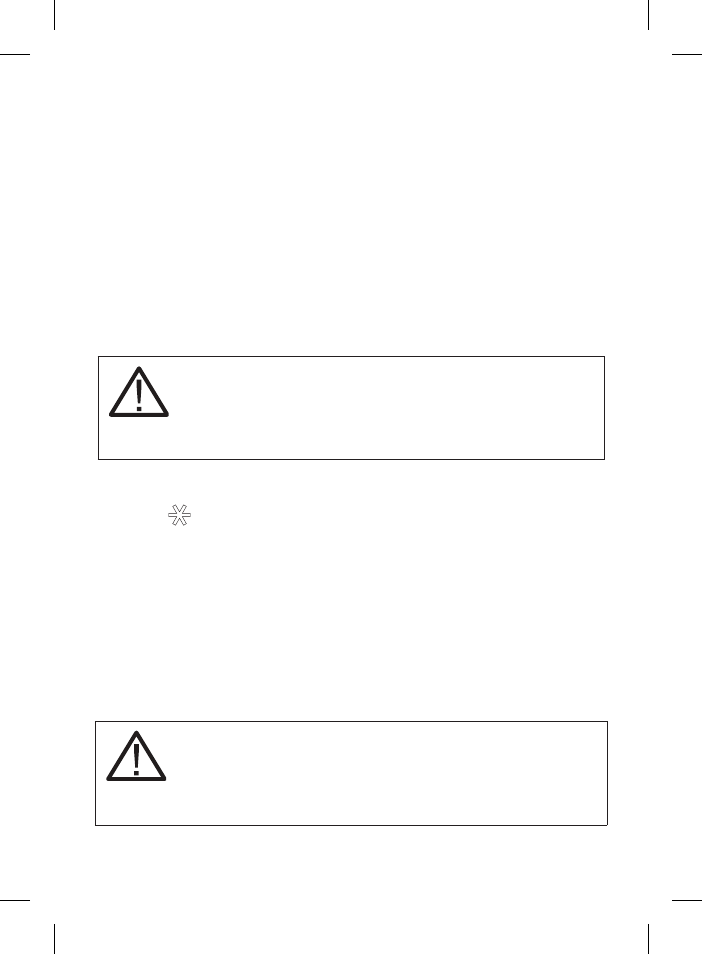
18 © 2010 Directed Electronics. All rights reserved.
The status LED lights solidly if you are en ter ing Valet Mode, and goes
off when you exit Valet Mode.
Remote start
This feature allows you to remotely start and run your vehicle for a
pro gram ma ble period of time. This makes it possible to warm up the
engine, as well as adjust the interior tem per a ture of the ve hi cle with
the climate control system. If interior heating or cooling is desired, the
climate controls must be preset, and the fan blower must be set to the
desired level prior to remote starting the vehicle.
Warning!
(1) Never remote start your vehicle when
the keys are in the ignition, except when performing
Valet® Take-Over, and (2) Never start the vehicle if it
is not in PARK or NEUTRAL
To remote start the vehicle:
• Press on the remote control once.
The parking lights flash to confirm that the vehicle will attempt to
start. With gas vehicles the engine starts 4 seconds after the park-
ing lights flash. With diesel vehicles the engine starts when the
WAIT-TO-START indicator on the dashboard goes out or the pro-
grammed delay has ended.
Once the vehicle has started, it runs for the pre- pro gram med pe-
riod of time (either 12, 24, or 60 minutes; See Programming Op-
tions section) or until a shutdown input is trig gered.
Warning!
It is unsafe to operate a vehicle’s motor in a
garage or other closed off area. Breathing the ex haust
from the vehicle is hazardous to your health. Never
activate the remote start in an enclosed space.

19
© 2010 Directed Electronics. All rights reserved.
When you are ready to drive the vehicle:
1. Insert the ignition key and turn it to the On position.
2. Press the brake pedal.
Note: If the brake pedal is pressed before the key is in the ON position,
the engine will shut down.
While the vehicle is running during remote start operation, the system
monitors the ve hi cle and automatically shuts down the engine if the
system receives any of the following:
• The brake pedal is pressed
• The hood is opened
• The shutdown toggle switch is put into the Off position.
• Runtime (12,24, or 60 minutes) expires
• Remote control button is pressed once.

20 © 2010 Directed Electronics. All rights reserved.
Valet take-over
The Valet Take-Over feature allows the vehicle to remain running after
the key has been removed from the ignition. This feature is useful for
occasions when you wish to exit and lock the vehicle for short periods
of time, but would like to leave the motor running and the climate
controls on.
To perform Valet Take-Over:
1. Before turning off the engine, press and release on the remote
control (or press and release the optional momentary switch). Then
wait five seconds.
2. Turn the ignition key to the OFF position. (The engine will stay run-
ning.) The engine will run until the pre-programmed time elapses
or a shut-down input is received. (See the previous Remote Start
section for a complete list of shut-down inputs.)
This feature will not work if the brake pedal is being pressed.
Power saver mode
Your system will automatically enter Power Saver Mode while armed/
locked or in Valet Mode, after a period of time in which no operation
has been performed. For more information, please refer to the expand-
ed version of this manual online at www.automatecarsecurity.com

21
© 2010 Directed Electronics. All rights reserved.
Diagnostics (security only)
The microprocessor at the heart of your system is constantly mon i tor ing
all of the switches and sensors connected to it. It is designed to detect
any faulty switches and sensors and prevents them from disabling the
entire system. The microprocessor will also record and report any trig-
gers that occurred during your absence. Refer to the Table of Zones
sections of this guide for diagnostic information.
Arming diagnostics
If the security system is armed at the same time that an input is active
(such as a door opening or sensor triggering), you will hear one siren/
horn sound to indicate arming and a second siren/horn sound to indi-
cate Bypass Notification.
A Bypass Notification sound means that the security system ignores
the input that was active when the system was armed, until that input
ceases. For more information, please refer to the expanded version of
this manual online at www.automatecarsecurity.com
Disarming diagnostics
Extra sounds that are heard when disarming the system are the Tamper
Alert. If four sounds are heard when disarming the system, then the
security system was triggered in your absence. If five sounds are heard
when disarming the system, a zone was triggered so many times that
the Nuisance Protection® Circuitry has bypassed that zone. For more
information, please refer to the expanded version of this manual online
at www.automatecarsecurity.com

22 © 2010 Directed Electronics. All rights reserved.
Table of zones
A zone is represented by the number of LED flashes used by the system
to identify a particular type of input. Standard input assignments are
listed in the following table, along with spaces to write in any optional
sensors or switches that have been installed.
Zone Description Dealer installed options
1 Trunk Pin
2 Instant trigger: a heavier impact detected by the
shock sensor
3 Door switch trigger
4 Instant trigger: for optional sensors
5 Ignition trigger
6 Hood Pin
Interpreting zone diagnostics
Warn Away responses are not reported by arming or disarming diag-
nostics. If you receive a Bypass notification when arming or a Tamper
Alert notification when disarming, look at the LED in the vehicle. Active
or triggered zones will be indicated by a pattern of blinks by the LED.
For example:
If zone 3 was active or triggered, the LED will blink three
times with a two-second pause. Then it will blink three times again, and
repeat until the ignition is turned on.
Your system stores the last two triggered zones in memory. If your system
has been triggered but the LED has been reset by turning on the igni-
tion, your dealer can still recall the last two zones that were triggered.
Contact your dealer for details.

23
© 2010 Directed Electronics. All rights reserved.
Government Regulations
This device complies with Part 15 of FCC rules. Operation is subject to the fol-
lowing two conditions: (1) This device may not cause harmful interference, and
(2) This device must accept any interference received, including interference that
may cause undesirable operation.
This equipment has been tested and found to comply with the limits for a class B
digital device, pursuant to Part 15 of the FCC Rules. These limits are designed to
provide reasonable protection against harmful interference in a residential instal-
lation. This equipment generates and can radiate radio frequency energy and,
if not installed and used in accordance with the instruction manual, may cause
harmful interference to radio communications. However, there is no guarantee
that interference will not occur in a particular installation. If this equipment does
cause harmful interference to radio or television, which can be determined by
turning the equipment OFF and ON, the user is encouraged to try to correct the
interference by one or more of the following measures:
• Reorient or relocate the receiving antenna.
• Increase the separation between the equipment and receiver.
• Connect the equipment into an outlet on a circuit different from that to which
the receiver is connected.
• Consult the dealer or an experienced radio / TV technician for help.
This device complies with the Industry Canada Radio Standards Specification
RSS 210. Its use is authorized only on a no-interference, no-protection basis; in
other words, this device must not be used if it is determined that it causes harm-
ful interference to services authorized by IC. In addition, the user of this device
must accept any radio interference that may be received, even if this interference
could affect the operation of the device.
Warning:
Changes or modifications not expressly approved by the party responsible for
compliance could void the user’s authority to operate this device.

24 © 2010 Directed Electronics. All rights reserved.
Warning! Safety First
The following safety warnings must be observed at all times:
Due to the complexity of this system, installation of this product must only
be performed by an authorized Directed dealer.
When properly installed, this system can start the vehicle via a com-
mand signal from the remote control/transmitter. Therefore, never oper-
ate the system in an enclosed area or partially enclosed area without
ventilation (such as a garage). When parking in an enclosed or par-
tially enclosed area or when having the vehicle serviced, the remote
start system must be disabled using the installed toggle switch. It is the
user’s sole responsibility to properly handle and keep out of reach from
children all remote control/transmitters to assure that the system does
not unintentionally remote start the vehicle. THE USER MUST INSTALL A
CARBON MONOXIDE DETECTOR IN OR ABOUT THE LIVING AREA
ADJACENT TO THE VEHICLE. ALL DOORS LEADING FROM ADJA-
CENT LIVING AREAS TO THE ENCLOSED OR PARTIALLY ENCLOSED
VEHICLE STORAGE AREA MUST AT ALL TIMES REMAIN CLOSED.
These precautions are the sole responsibility of the user.
Use of this product in a manner contrary to its intended mode of op-
eration may result in property damage, personal injury, or death. (1)
Never remotely start the vehicle with the vehicle in gear, and (2) Never
remotely start the vehicle with the keys in the ignition. The user must
also have the neutral safety feature of the vehicle periodically checked,
wherein the vehicle must not remotely start while the car is in gear. This
testing should be performed by an authorized Directed dealer in accor-
dance with the Safety Check outlined in the product installation guide.
If the vehicle starts in gear, cease remote start operation immediately
and consult with the authorized Directed dealer to fix the problem.

25
© 2010 Directed Electronics. All rights reserved.
After the remote start module has been installed, contact your autho-
rized dealer to have him or her test the remote start module by perform-
ing the Safety Check outlined in the product installation guide. If the
vehicle starts when performing the Neutral Safety Shutdown Circuit
test, the remote start unit has not been properly installed. The remote
start module must be removed or the installer must properly reinstall the
remote start system so that the vehicle does not start in gear. All installa-
tions must be performed by an authorized Directed dealer.
OPERATION OF THE REMOTE START MODULE IF THE VEHICLE STARTS
IN GEAR IS CONTRARY TO ITS INTENDED MODE OF OPERATION.
OPERATING THE REMOTE START SYSTEM UNDER THESE CONDI-
TIONS MAY RESULT IN PROPERTY DAMAGE OR PERSONAL INJURY.
YOU MUST IMMEDIATELY CEASE THE USE OF THE UNIT AND SEEK
THE ASSISTANCE OF AN AUTHORIZED DIRECTED DEALER TO RE-
PAIR OR DISCONNECT THE INSTALLED REMOTE START MODULE.
DIRECTED WILL NOT BE HELD RESPONSIBLE OR PAY FOR INSTALLA-
TION OR REINSTALLATION COSTS.
Caution
This product is designed for fuel injected, automatic transmission ve-
hicles only. Use of this product in a standard transmission vehicle is
dangerous and contrary the product’s intended use.

26 © 2010 Directed Electronics. All rights reserved.
Patent Information
This product is covered by one or more of the following U.S. patents:
303,223 345,711 4,383,242 5,103,221 5,534,845 5,907,195
333,633 347,190 4,438,426 5,117,217 5,572,185 5,914,667
333,634 348,622 4,553,127 5,132,660 5,646,591 5,945,936
333,635 352,685 4,584,569 5,193,141 5,656,997 5,952,933
333,636 383,689 4,794,368 5,245,694 5,712,638 5,990,786
333,795 383,690 4,887,064 5,285,186 5,783,989
340,000 390,830 4,897,630 5,315,285 5,798,711
344,905 392,944 4,922,224 5,357,560 5,872,519
345,317 4,327,444 4,987,402 5,532,670 5,900,806
International Patents:
Australia: 694,925
Canada: 1,315,859 and 2,067,099
Taiwan: 91817
Other patents pending


Español
Guía del propietario
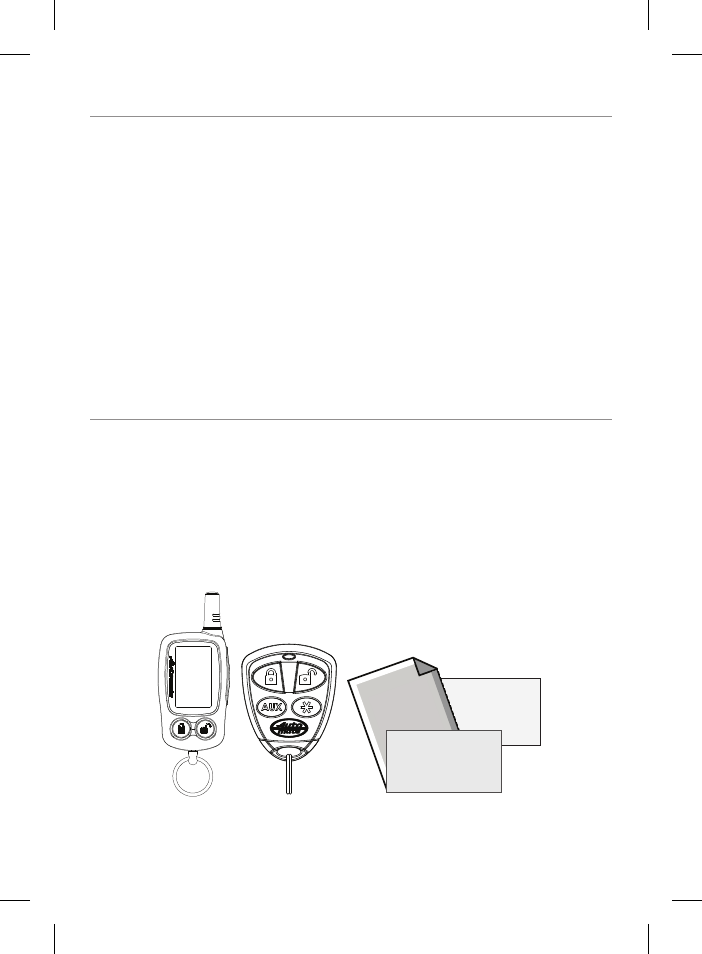
i
© 2010 Directed Electronics. Reservados todos los derechos.
Felicitaciones
Felicitaciones por la compra de su sistema de arranque a distancia
y entrada sin llave con tecnología de vanguardia. Leer la guía del
propietario antes de utilizar el sistema maximiza la implementación y
las diversas características del sistema. Hay más información en www.
automatecarsecurity.com.
Si tiene preguntas, comuníquese con el distribuidor autorizado de Di-
rected, o con Directed llamando a 1-800-753-0600. También hay
apoyo adicional en http://support.directed.com.
Contenido
• Control remoto bidireccional de 5 botones con pantalla LCD
• Control remoto unidireccional de 4 botones
• Tarjeta de registro
• Tarjeta de referencia rápida
• Esta guía del propietario
Tarjeta de
garantía
Guía del
propietario
Tarjeta de
referencia rápida

Información importante
Reglamentos del gobierno e información de seguridad
Lea las secciones Reglas del gobierno y ¡Advertencia!
Seguridad primero de este manual antes de hacer fun-
cionar el sistema.
¡Advertencia!
No seguir estas instrucciones puede cau-
sar muerte, lesiones personales o daños a la propiedad.
También puede causar ilegalidad por usar el sistema
para objetivos no previstos.
Garantía
Su sistema viene con una garantía. Asegúrese de recibir la tarjeta de
registro de garantía y el comprobante de compra de parte de su distri-
buidor indicando que el producto fue instalado por un distribuidor au-
torizado de Directed. La garantía de producto debe validarse menos
de 10 días después de la compra. Puede validarla en línea en www.
prodregister.com/automate o llenar la tarjeta de registro de garantía
y enviarla por correo.
Reemplazo de controles remotos
Si desea más controles remotos, llame al distribuidor autorizado o
vaya a www.directedstore.com para pedirlos. El número de pieza
del repuesto bidireccional es 477A. El número de pieza del repuesto
unidireccional es 474A.

1
© 2010 Directed Electronics. Reservados todos los derechos.
Contenido
Felicitaciones .....................................................................................................i
Contenido .........................................................................................................i
Información importante ......................................................................................ii
Garantía .................................................................................................ii
Reemplazo de controles remotos.................................................................ii
Inicio ...............................................................................................................3
Mantenimiento del sistema .........................................................................3
Cambio de la pila ....................................................................................3
Control remoto bidireccional con pantalla LCD .....................................................4
Centro de control ......................................................................................5
Iconos de pantalla ...................................................................................6
Comandos básicos ............................................................................................8
Armado o bloqueo ...................................................................................8
Desarmado o desbloqueo ..........................................................................8
AUX ........................................................................................................8
Arranque a distancia ................................................................................9
Iluminación de fondo de la pantalla LCD .....................................................9
Comandos avanzados .....................................................................................10
Funciones auxiliares. ...............................................................................10
Modalidad de temporización ...................................................................10
Modalidad de temporización turbo de corta duración ................................10
Desempañador opcional de la ventana trasera ..........................................10
Modalidad de arranque por temperatura ..................................................11
Temperatura interna ................................................................................11
Reloj de hora y alarma ............................................................................11
Temporizador de estacionamiento ............................................................12
Aviso de pitido o vibración ......................................................................12
Ahorro de energía ..................................................................................12
Operación a distancia .....................................................................................13
Características de llamado ......................................................................13
Fijación de la hora del reloj .....................................................................13
Operaciones a distancia y de sistema ...............................................................14
Armado o bloqueo pasivo .......................................................................14
Respuesta de advertencia de alejamiento (Warn Away®) (sólo seguridad) ....14
Respuesta por activación (sólo seguridad)..................................................15
Armado de seguridad de varios niveles (sólo seguridad) .............................16
Armado mientras se conduce (sólo seguridad) ...........................................16
Desarmado de alta seguridad (sólo seguridad) ..........................................17
Anulación de emergencia ........................................................................17
Modalidad de valet ................................................................................18
Arranque a distancia ..............................................................................18

2© 2010 Directed Electronics. Reservados todos los derechos.
Transferencia de control al valet ...............................................................20
Modalidad de ahorro de energía .....................................................................21
Diagnóstico (sólo seguridad) ............................................................................21
Diagnóstico de armado ...........................................................................21
Diagnóstico de desarmado ......................................................................21
Reglamentos del gobierno ................................................................................24
¡Advertencia! Seguridad primero ......................................................................25
Precaución .............................................................................................26
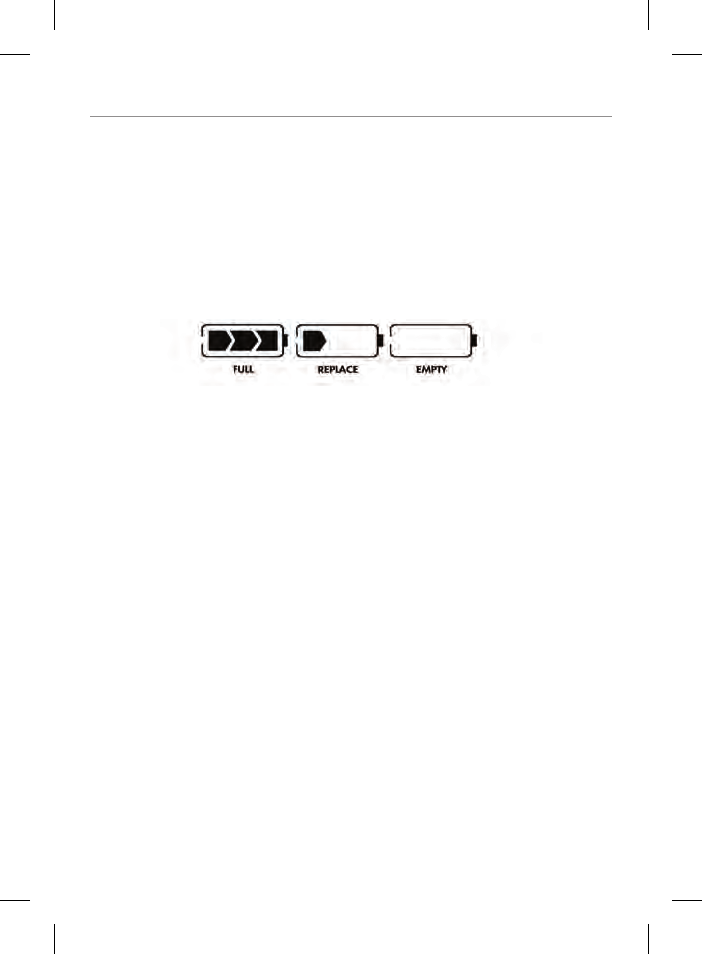
3
© 2010 Directed Electronics. Reservados todos los derechos.
Inicio
Mantenimiento del sistema
El sistema no requiere mantenimiento específico, fuera de cambiarles
las pilas a los controles remotos. El control remoto bidireccional tiene
una pila de 1.5 V tipo AAA. La pantalla LCD tiene 3 barras para indi-
car la carga de la pila. Cuando la pila se gasta al punto en que hay
que cambiarla, el control remoto genera un solo sonido de aviso y el
indicador de pila destella continuamente.
El control remoto unidireccional tiene una pila tipo moneda (CR-2032)
que se puede comprar en la mayoría de las tiendas al detalle. El al-
cance disminuye a medida que la pila se gasta.
Cambio de la pila
Abra el compartimento de la pila (que se encuentra en la parte de
atrás del control remoto) deslizando cuidadosamente la lengüeta de
apertura de la tapa. Luego deslice la tapa hacia afuera para exponer
la pila agotada. Quite la pila agotada. Ponga una pila nueva en el
control remoto verificando la polaridad. Cuando se restablece la ali-
mentación, todos los iconos de la pantalla LCD aparecen y el control
remoto toca una melodía.
Cambio de la pila del control remoto unidireccional
Ubique la pequeña ranura en el lado del control remoto. Inserte un
destornillador plano pequeño o una herramienta equivalente en la
ranura y haga palanca para abrir la caja. Al cambiar la pila verifique
la polaridad, luego cierre la caja a presión.
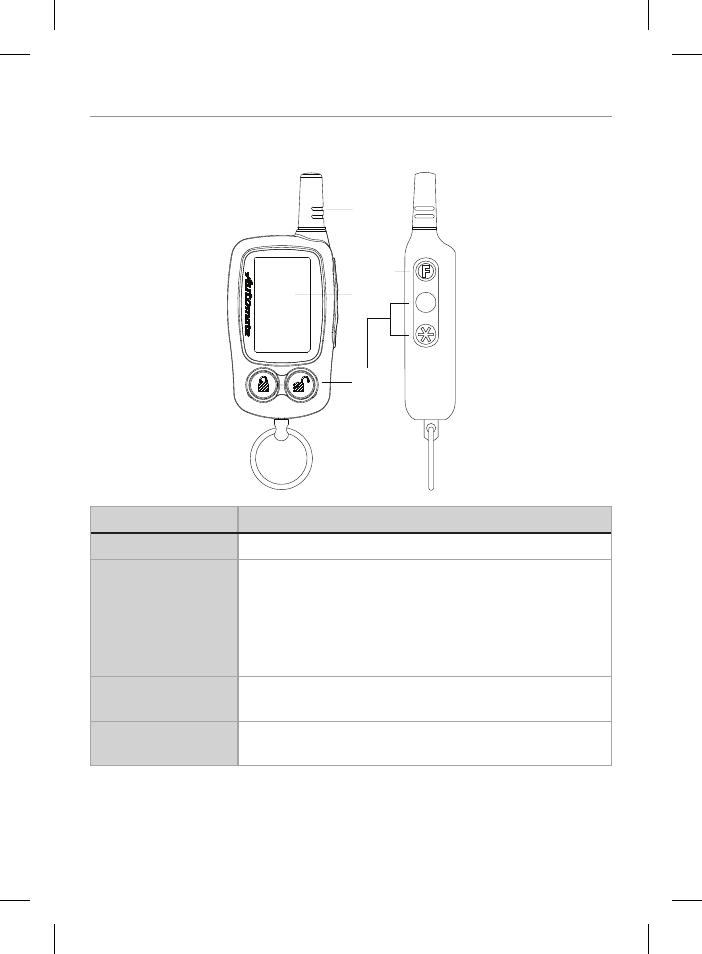
4© 2010 Directed Electronics. Reservados todos los derechos.
Control remoto bidireccional con pantalla LCD
AUX
Vista delantera Vista lateral
Botones de
comando
Botón de
funciones
Pantalla
Antena
Característica Descripción
Antena interna Para transmitir y recibir información
Pantalla Campo de texto, parte superior de la pantalla, muestra el
reloj, la duración del arranque a distancia o la temperatura.
Pantalla de estado, parte inferior de la pantalla, con-
tiene los iconos de estado del sistema, la sirena o el
claxon, las zonas de alarma, el arranque a distancia
y el control remoto.
Botones de comando
(4)
Para emitir comandos de armado o bloqueo, desarmado o
desbloqueo, canal auxiliar y arranque a distancia
Botón de funciones Para encender la luz de fondo o ver la modalidad de ajuste
y los comandos avanzados

5
© 2010 Directed Electronics. Reservados todos los derechos.
Centro de control
Botón
Indicador LED
Antena
El centro de control está por lo general en la parte de arriba del para-
brisas delantero e intercambia comandos o mensajes con el sistema.
Consta de lo siguiente:
• La antena de sistema interna del vehículo: para la comunicación
bidireccional.
• El indicador LED del centro de control: indicador visual del estado
del sistema.
• El botón central del control (botón de valet): para poner el sistema
en modalidad de valet* y para llevar a cabo la operación de
anulación de emergencia*.
* Vea los detalles en la sección Operaciones a distancia y de sistema.
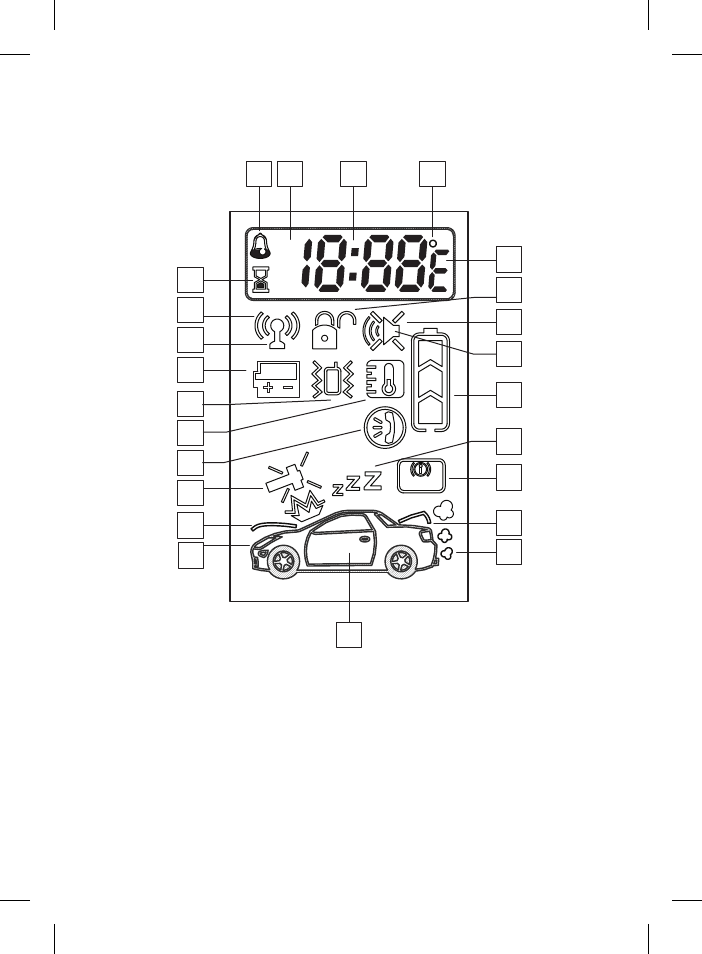
6© 2010 Directed Electronics. Reservados todos los derechos.
Iconos de pantalla
AM
PM
INHIBIT
SAVE
A
1
234
5
6
7
8
9
10
11
12
13
16
17
18
19
20
22
21
23
24
15
14

7
© 2010 Directed Electronics. Reservados todos los derechos.
Ítem Descripción
1 Indicador de temperatura interior del vehículo
2 Pantalla numérica
3 Indicador AM/PM
4 Indicador de modalidad de reloj con alarma
5 Indicador de la función de temporización
6Indicación de transmisión
7Indicador de alcance de transmisión
8Indicador de modalidad de ahorro de energía
9 Indicador de modalidad de vibración o pitido
10 Indicador de arranque a distancia controlado por temperatura
11 Indicador de modalidad de llamado al vehículo
12 Indicador del sensor de impacto con activación total
13 Indicador de activación o de capó o maletero abierto
14 Indicador de la luz de estacionamiento
15 Indicador de activación o puerta abierta
16 Indicador de arranque a distancia
17 Indicador de activación o capó o maletero abierto
18 Indicador de desactivación de seguridad del arranque a distancia
19 Indicador de la modalidad de valet
20 Indicador de carga de la batería
21 Indicador de alerta de activación total
22 Indicador de la modalidad de armado o bloqueo o de desarmado
o desbloqueo silencioso
23 Indicador de armado o bloqueo o de desarmado o desbloqueo
24 Indicador de Celsius o Fahrenheit

8© 2010 Directed Electronics. Reservados todos los derechos.
Comandos básicos
Nota: La configuración de botones también se aplica al control remoto
unidireccional.
Armado o bloqueo
Oprima
y suelte el botón
La alarma se activa, las puertas se bloquean (si están conectadas), la
sirena o el claxon suena y las luces de estacionamiento destellan una
vez. Si la modalidad de valet* está activada, las puertas se bloquean
y aparece el indicador de armado o bloqueo.** Salga de la modali-
dad de valet para armar o bloquear la alarma normalmente.
Armado o bloqueo y función de pánico
Oprima
y
mantenga oprimido
el botón
La alarma se arma (o se bloquea en la modalidad de valet) y,
después de 2 segundos, la sirena o el claxon suena y las luces de
estacionamiento destellan.
Desarmado o desbloqueo
Oprima
y
suelte el botón
La alarma se desarma, las puertas se desbloquean (si están conecta-
das), la sirena o el claxon suena y las luces de estacionamiento destel-
lan 2 veces. Se desactiva la función de pánico, si estaba activada.
Si la modalidad de valet* está activada (ON) las puertas se desblo-
quean y aparece el indicador de desarmado o desbloqueo.**
AUX
Oprima
y
suelte el botón
Haga esto antes de emitir el comando de armado o bloqueo o de
desarmado o desbloqueo para utilizar el control remoto en modalidad
silenciosa Silent Mode™.

9
© 2010 Directed Electronics. Reservados todos los derechos.
Función opcional (apertura de maletero)
Oprima
y
mantenga oprimido
el botón
Activa la salida auxiliar, que puede ser la apertura del maletero
o una función auxiliar que usted le haya agregado al sistema. La
salida auxiliar controla: .
Arranque a distancia
Oprima
y suelte el botón
Activa (o si está activado, desactiva) el arranque a distancia. El motor
y las luces de estacionamiento se encienden.
Iluminación de fondo de la pantalla LCD
Oprima
y suelte el botón **
La iluminación de fondo de la pantalla LCD se activa.
Para entrar a la modalidad de ajuste
Oprima
y
mantenga oprimido
el botón
Cuando se mantiene oprimido durante más de 5 segundos, el
control remoto entra a la modalidad de ajuste para permitir la
fijación de la hora del reloj, la modalidad de temporización y la
selección de la melodía audible. Para obtener más información,
vaya a la sección Comandos avanzados o consulte la versión
larga de este manual en www.automatecarsecurity.com.
* Los detalles se encuentran en la sección Operaciones a distancia y de
sistema.
** Sólo para el control remoto bidireccional
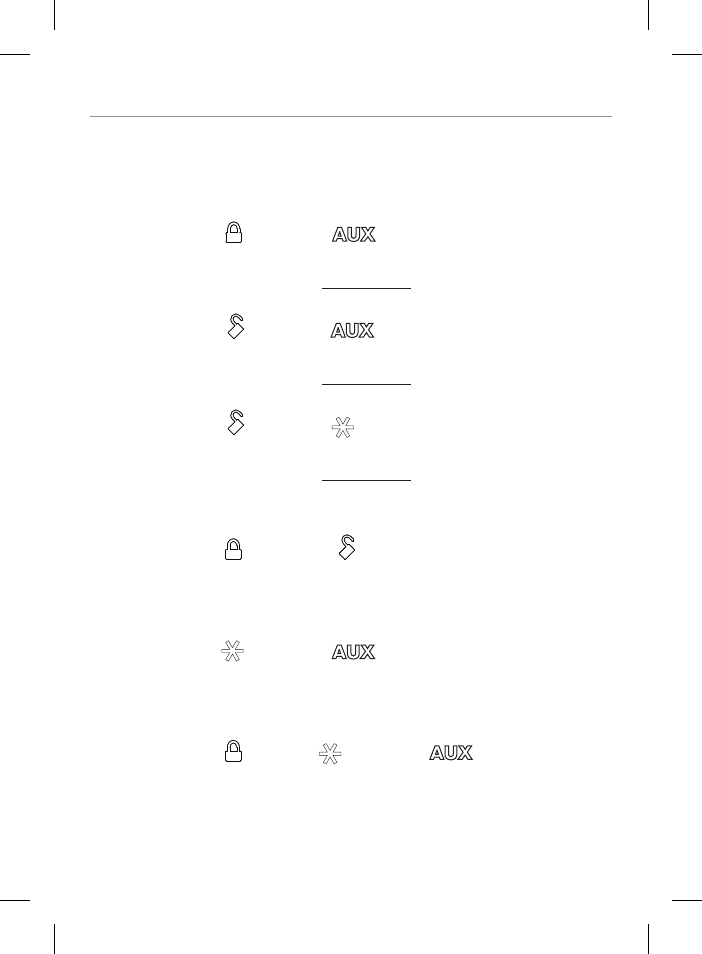
10 © 2010 Directed Electronics. Reservados todos los derechos.
Comandos avanzados
Nota: La configuración de botones también se aplica al control remoto
unidireccional.
Funciones auxiliares.
Oprima
el botón y el botón simultáneamente.
Esto activa una función auxiliar que usted le haya agregado al sistema.
La salida auxiliar controla
Oprima
el botón
y el botón simultáneamente.
Esto activa una función auxiliar que usted le haya agregado al sistema.
La salida auxiliar controla
Oprima
el botón
y el botón simultáneamente.
Esto activa una función auxiliar que usted le haya agregado al sistema.
La salida auxiliar controla
Modalidad de temporización
Oprima
el botón
y el botón
simultáneamente.
Activa la modalidad de temporización.
Modalidad de temporización turbo de corta duración
Oprima
el botón
y el botón simultáneamente.
Activa la modalidad de temporización de corta duración.
Desempañador opcional de la ventana trasera
Oprima
el botón
el botón y el botón simultáneamente.
Activa el desempañador opcional de la ventana trasera. Las luces de
estacionamiento destellan 2 veces y el desempañador trasero no se
activa cuando el vehículo se arranca a distancia. Cuando se repite el
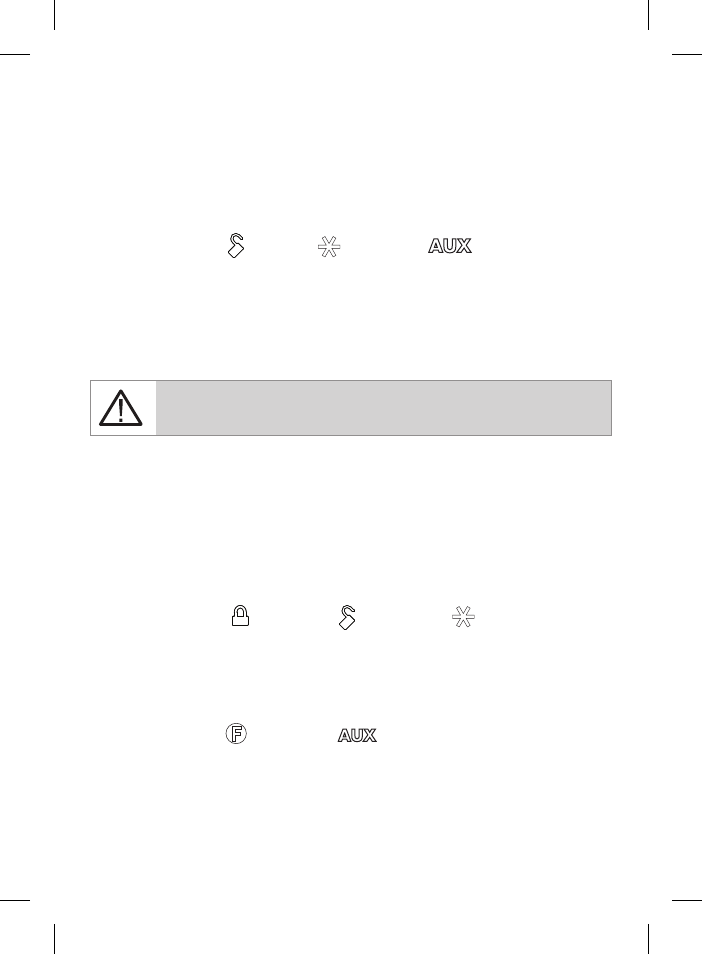
11
© 2010 Directed Electronics. Reservados todos los derechos.
mismo procedimiento, el desempañador se activa y las luces de estac-
ionamiento destellan 3 veces. Si la temperatura interior del vehículo es
más de 55 °F cuando se activa el arranque a distancia, el desempa-
ñador trasero no se activa.
Modalidad de arranque por temperatura
Oprima
el botón
el botón y el botón simultáneamente.
Activa la modalidad de arranque por temperatura. Las luces de es-
tacionamiento destellan rápidamente 4 veces para confirmar la ac-
tivación. El motor no arranca cuando la función se activa, arranca
cuando la temperatura interior del vehículo llega a menos de 0 °F.
¡Advertencia!
El vehículo debe estar estacionado en un
lugar bien ventilado cuando se utilice esta característica.
Desactive la modalidad de arranque por temperatura oprimiendo los
mismos botones nuevamente o pasando la llave a la posición de en-
cendido (ON). Las luces de estacionamiento destellan lentamente 4
veces para confirmar desactivación.
Temperatura interna
Oprima
el botón
el botón
y el botón simultáneamente.
(2-way only)
La temperatura interna del vehículo aparece en la pantalla LCD.
Reloj de hora y alarma
Oprima
el botón
y el botón simultáneamente. (sólo bidirec-
cional)
La pantalla numérica pasa de la hora del día a la hora de la alarma y
viceversa cuando estos botones se oprimen simultáneamente.
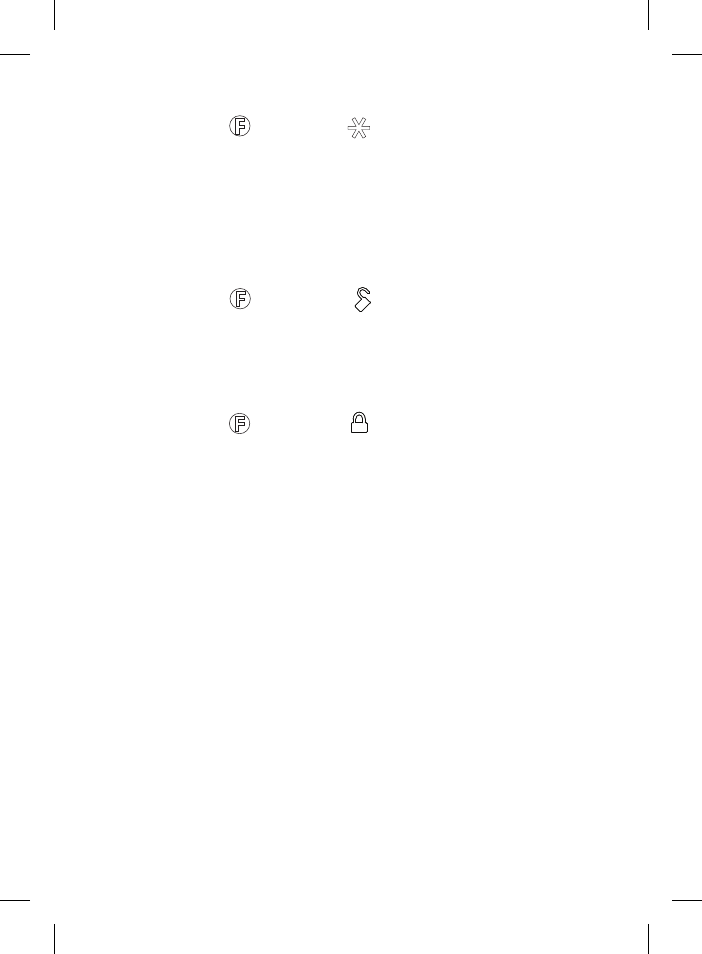
12 © 2010 Directed Electronics. Reservados todos los derechos.
Temporizador de estacionamiento
Oprima
el botón
y el botón simultáneamente. (sólo bidirec-
cional)
Activa el temporizador de estacionamiento. Cada vez que se oprimen
los botones se pasa a la siguiente opción disponible (10 min., 20
min., 30 min., 1 hora, 1.5 horas, 2 horas y desactivado {Off}).
Aviso de pitido o vibración
Oprima
el botón
y el botón
simultáneamente. (sólo bidirec-
cional)
Pasa del aviso con pitido al aviso con vibración y viceversa.
Ahorro de energía
Oprima
el botón
y el botón simultáneamente. (sólo bidirec-
cional)
Activa la modalidad de ahorro de carga de pila. Reduce el consumo
de carga de la pila del control remoto cuando la alarma no está acti-
vada o está desarmada o desbloqueada.

13
© 2010 Directed Electronics. Reservados todos los derechos.
Operación a distancia
El sistema de arranque a distancia funciona a 434 MHz y tiene un
control remoto bidireccional fuera de borda A.S.K. propiedad de Di-
rected. La alta frecuencia combinada con la comunicación de datos
binarios permite largo alcance en la comunicación bidireccional.
Características de llamado
El módulo de control llama al control remoto para confirmar que ha
recibido un comando o un estado de sistema de alarma.
Cuando recibe el llamado, el control remoto pita o vibra y la indicación
del estado de alarma, armado o bloqueado o bien desarmado o des-
bloqueado (el icono de bloqueo o desbloqueo) aparece en la pantalla
LCD. Si la alarma se ha activado, la pantalla LCD del control remoto
presenta la zona activada. Para despejar la página de alarma, oprima
cualquier botón del control remoto. La información de la pantalla LCD
también desaparece.
Nota: No se pueden enviar comandos hasta que se despeje la pá-
gina de alarma.
Fijación de la hora del reloj
Para fijar la hora del reloj
oprima
y
mantenga oprimido
el botón
durante 5 segundos. El transmisor-receptor suena 2 veces y la
selección de la hora comienza a destellar.
Oprima
inmediatamente
el botón para adelantar la hora o el botón para atrasarla.
Una vez que aparezca la hora correcta,
oprima
el botón
nuevamente y la selección de minutos comenzará a destellar.
Oprima
el botón para aumentar la indicación de los minutos o el botón
para reducirla. Una vez que aparezca la hora correcta en la pantalla
LCD, deje de oprimir botones durante 15 segundos y el transmisor-receptor
saldrá automáticamente de la modalidad de reloj.

14 © 2010 Directed Electronics. Reservados todos los derechos.
Operaciones a distancia y de sistema
Armado o bloqueo pasivo
El sistema se puede programar para que se arme o se bloquee automáti-
camente (esto se llama armado o bloqueo pasivo). Si se programa para
armado o bloqueo pasivo, el sistema se arma o se bloquea automática-
mente 30 segundos después de que se pasa la llave a la posición de
apagado (OFF) y el sistema detecta que usted ha salido del vehículo
abriendo y cerrando una puerta. Cuando el sistema está contando los
30 segundos para el armado o bloqueo pasivo, el indicador LED de
estado destella 2 veces con el doble de la rapidez con que destella
cuando el sistema está armado o bloqueado. Cuando llega a los 20
segundos, la sirena o el claxon suena para indicar que el sistema está
a punto de armarse o bloquearse. Cuando llega a los 30 segundos,
las luces de estacionamiento destellan para indicar que el sistema está
armado o bloqueado.
Nota: Si algún punto de entrada protegido (una puerta o un maletero
o capó protegido con interruptor) se abre, el sistema no se arma o
bloquea pasivamente (a menos que la programación lo fuerce). Con-
sulte la sección Opciones de programación en la versión larga de este
manual en www.automatecarsecurity.com.
Respuesta de advertencia de alejamiento (Warn Away®) (sólo
seguridad)
La respuesta de advertencia de alejamiento consta de un llamado de
alarma y las respuestas que se describen a continuación.
• Sensor de impacto. Los impactos leves en el vehículo causan
destellos de luces y sonido de la sirena o el claxon durante unos
segundos.

15
© 2010 Directed Electronics. Reservados todos los derechos.
• Aviso de control remoto. 10 pitidos rápidos (o una vibración).
• El control remoto entra en la modalidad de reconocimiento de
llamado y hace funcionar las alertas de llamado de alarma.
Nota: Los iconos 12 y 13 representan entradas de zona del sistema
de alarma. Para obtener más información sobre los iconos y las zo-
nas que representan consulte la sección Configuración de botones y
descripción de iconos en la versión larga de este manual en www.
automatecarsecurity.com.
Respuesta por activación (sólo seguridad)
Cualquiera de los activadores puede producir una respuesta por ac-
tivación, que consta de un llamado de alarma y una respuesta corre-
spondiente, que se describe a continuación. La duración preestableci-
da de la respuesta por activación es 30 segundos, pero el instalador
puede programarla de 1 a 180 segundos.
• Activación desde el sensor de impacto. Los impactos pesados pro-
ducen instantáneamente el sonido de la sirena o el claxon y el
destello de las luces durante el período programado. Se emite un
reporte de Zona 2.
• Activación desde la puerta. Si se abre una puerta, la sirena o el
claxon suena y las luces destellan durante 3 segundos, luego la
sirena o el claxon suena continuamente y las luces destellan durante
el período programado. Se emite un reporte de Zona 3. Los 3
segundos le dan tiempo al usuario para desarmar o desbloquear el
sistema con un mínimo de ruido si se abre la puerta por accidente
con el sistema armado o bloqueado.
• Activación desde el capó. Si se abre el capó, la sirena o el claxon
suena y las luces destellan durante el período programado. Se
emite un reporte de Zona 1.

16 © 2010 Directed Electronics. Reservados todos los derechos.
• Activación desde el maletero. Abrir el maletero (si está conectado)
produce instantáneamente el sonido de la sirena o el claxon y las
luces destellan durante el período programado. Se emite un reporte
de Zona 4.
• Activación desde el encendido. Pasar la llave a la posición de
encendido (ON) produce la misma respuesta progresiva que la
activación desde la puerta. Se emite un reporte de Zona 5.
Cuando se produce una respuesta por activación, el control remoto
bidireccional:
• Emite 4 pitidos rápidos (o vibra) durante 15 segundos.
• El icono de alerta de activación total (28) se mantiene encendido
15 segundos.
Armado de seguridad de varios niveles (sólo seguridad)
El armado de seguridad de varios niveles permite seleccionar las en-
tradas o sensores del sistema que se activarán y las que se pasarán
por alto cuando el sistema se arme. Consulte la versión larga de este
manual en www.automatecarsecurity.com
Armado mientras se conduce (sólo seguridad)
Su sistema de seguridad se puede armar mientras usted vaya conduci-
endo el vehículo. Oprima el botón del control remoto durante 2
segundos con el vehículo en movimiento. La sirena o el claxon suena
una vez para indicar que el sistema de seguridad está armado y luego
una vez más para indicar que la llave está en la posición de encen-
dido (ON). El sistema no responde a ninguna entrada, excepto las
activaciones desde la puerta. El relé de anulación de arranque (si está
instalado) no se activa. Una vez que llegue a su destino, el sistema se
desarma cuando la llave se pasa a la posición de apagado (OFF). La
sirena o el claxon suena 2 veces y la pantalla LCD deja de destellar. El
sistema también se puede desarmar oprimiendo el botón

17
© 2010 Directed Electronics. Reservados todos los derechos.
Desarmado de alta seguridad (sólo seguridad)
Este sistema de seguridad ofrece desarmado de alta seguridad. El
desarmado de alta seguridad es una característica que permite silen-
ciar y restablecer el sistema sin desarmarlo mientras está en proceso
de activación. Consulte la versión larga de este manual en www.
automatecarsecurity.com
Anulación de emergencia
Si el control remoto se le pierde o se le daña, puede desarmar el
sistema de seguridad del vehículo o inhabilitar la anulación de ar-
ranque opcional manualmente. Para desarmar o inhabilitar el sistema
sin control remoto, se debe tener la llave del vehículo.
Desarmado o inhabilitación del sistema:
1. Pase la llave a la posición de encendido (ON)
2. Oprima el botón central del control el número de veces prees-
tablecido (de 1 a 5 veces) en menos de 15 segundos. El valor
preestablecido de fábrica es una vez. Después de 5 segundos, el
sistema se desarma o se inhabilita. Si el sistema no se desarma o
inhabilita, es posible que haya esperado demasiado. Comience
de nuevo pasando la llave a la posición de apagado (OFF) y
luego a la posición de encendido (ON).
Número de veces _____________________________________
Importante:
El botón central de control se puede programar
para que responda a oprimirlo de 1 a 5 veces para la función
de desarmado o inhabilitación. Hable con el instalador para
verificar la programación de su unidad.

18 © 2010 Directed Electronics. Reservados todos los derechos.
Modalidad de valet
La modalidad de valet permite evitar que el sistema se arme o se blo-
quee y emita activaciones automáticamente. Esto es muy útil cuando
se está lavando el vehículo o cuando se le está haciendo servicio. En
la modalidad de valet, la anulación de arranque no se arma ni se
habilita, ni siquiera con el control remoto, pero todas las funciones de
conveniencia (bloqueo de puertas, apertura del maletero, etc.) siguen
funcionando normalmente.
Para entrar o salir de la modalidad de valet:
1. Pase la llave a la posición de encendido (ON).
2. Pase la llave a la posición de apagado (OFF).
3. Oprima y suelte el botón central de control en menos de 10 se-
gundos.
Para entrar o salir de la modalidad de valet con control remoto:
4. Abra cualquier puerta del vehículo.
5. Oprima el botón .
6. Oprima el botón y luego oprima el botón nuevamente
Los indicadores LED de estado se mantienen encendidos uniforme-
mente cuando se entra a la modalidad de valet y se apagan cuando
se sale de la modalidad de valet.
Arranque a distancia
Esta característica permite arrancar el vehículo a distancia y dejar
andando el motor durante un período de tiempo programado. Esto
permite calentar el motor y ajustar la temperatura interior del vehículo
con el sistema de control de clima. Si desea calefaccionar o enfriar
el interior, los controles de clima deben configurarse de antemano y
el ventilador debe ajustarse al nivel deseado antes de arrancar el
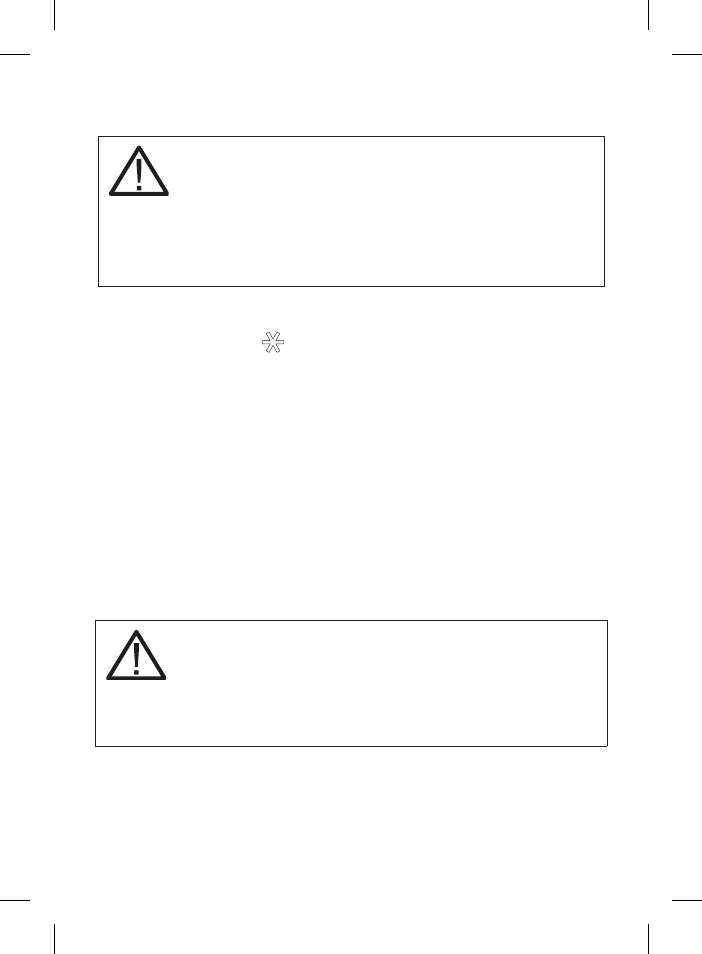
19
© 2010 Directed Electronics. Reservados todos los derechos.
vehículo a distancia.
¡Advertencia!
(1) No arranque nunca el vehículo con
las llaves puestas, excepto cuando esté haciendo una
transferencia de control al valet (Valet® Take-Over)
y (2) No arranque nunca el vehículo si no tiene la
palanca de marchas en la posición de estacionado
(P) o neutro (N)
Para arrancar el vehículo a distancia:
• Oprima el botón del control remoto una vez.
• Las luces de estacionamiento destellan para confirmar que el vehí-
culo está intentando arrancar. En vehículos de gasolina, el motor
arranca 4 segundos después de que las luces de estacionamiento
destellan. En vehículos diesel, el motor arranca cuando se acaba
el período de espera para arrancar establecido en el temporiza-
dor.
• Una vez que el vehículo arranca, el motor anda durante el perío-
do de tiempo preestablecido (12, 24 ó 60 minutos) o hasta que
la señal de apagado se active. Vea la sección Opciones de pro-
gramación.
¡Advertencia!
Es peligroso hacer funcionar el mo-
tor del vehículo en un garaje o en un lugar cerrado.
Respirar los gases de escape del vehículo es pelig-
roso para la salud. No active nunca el arranque a
distancia en un espacio cerrado.
Cuando esté listo para manejar el vehículo:
1. Inserte la llave y pásela a la posición de encendido (ON)
2. Pise el pedal del freno.

20 © 2010 Directed Electronics. Reservados todos los derechos.
Nota: Si el pedal de freno se pisa antes de que la llave esté en la
posición de encendido (ON), el motor se apaga.
Cuando el vehículo está funcionando durante la operación de ar-
ranque a distancia, el sistema vigila el vehículo y apaga automática-
mente el motor si se da alguna de las siguientes situaciones:
• Se pisa el pedal del freno.
• Se abre el capó.
• El interruptor de apagado se pone en la posición de apagado
(OFF).
• El período de funcionamiento preestablecido (12, 24 ó 60 minu-
tos) se acaba.
• Se oprime una vez el botón del control remoto.
Transferencia de control al valet
La característica de transferencia de control al valet le permite al motor
continuar andando después de que se ha sacado la llave del encen-
dido. Esta característica es útil cuando uno desea salir del vehículo,
cerrarlo y dejarlo cerrado durante cortos períodos de tiempo con el
motor andando y los controles de clima encendidos.
Para hacer una transferencia de control al valet:
1. Antes de apagar el motor, oprima y suelte el botón del control
remoto (u oprima y suelte el interruptor momentáneo opcional). Luego es-
pere 5 segundos.
2. Pase la llave a la posición de apagado (OFF). El motor seguirá andando
hasta que pase el período de funcionamiento preestablecido o se reciba
una señal de apagado. (En la sección Arranque a distancia hay una lista
completa de señales de apagado).
Esta característica no funciona si se pisa el pedal de freno.

21
© 2010 Directed Electronics. Reservados todos los derechos.
Modalidad de ahorro de energía
El sistema entra automáticamente en la modalidad de ahorro de en-
ergía mientras esté armado o bloqueado o en modalidad de valet
después de un período en que no se haga ninguna operación. Con-
sulte la versión larga de este manual en www.automatecarsecurity.com
Diagnóstico (sólo seguridad)
El microprocesador en el núcleo del sistema vigila constantemente
todos los interruptores y sensores que tiene conectados. Este micro-
procesador está diseñado para detectar interruptores y sensores que
fallen e impedirles que inhabiliten todo el sistema. El microprocesador
también anota y comunica todas las activaciones que ocurrieron en su
ausencia. En la sección Tabla de zonas de esta guía hay información
sobre diagnóstico.
Diagnóstico de armado
Si el sistema de seguridad se arma cuando hay una activación en
curso (se está abriendo una puerta o un sensor está enviando una
señal de activación) la sirena o el claxon suena una vez para indicar
el armado y una segunda vez para indicar un paso por alto.
El sonido del aviso de paso por alto significa que, cuando se está
armando, el sistema de seguridad ignora la señal de activación en
curso hasta que se acabe. Consulte la versión larga de este manual en
www.automatecarsecurity.com
Diagnóstico de desarmado
Los sonidos adicionales que se oyen cuando se desarma el sistema son
la alerta contra modificación. Si suena 4 veces cuando se está desar-

22 © 2010 Directed Electronics. Reservados todos los derechos.
mando, el sistema de seguridad fue activado en su ausencia. Si suena
5 veces cuando se desarma, una de las zonas se activó tantas veces
que el Circuito de Protección contra Molestias (Nuisance Protection®
Circuitry) la pasó por alto. Consulte la versión larga de este manual en
www.automatecarsecurity.com
Tabla de zonas
Las zonas se representan por el número de destellos del indicador LED
con que el sistema identifica las señales de activación. La asignación
estándar de señales de activación aparece en la siguiente tabla, que
tiene espacio para anotar los sensores o interruptores opcionales que
se han instalado.
Zona Descripción Opciones instaladas por
el distribuidor
1 Clavija del maletero
2 Activación instantánea: impacto pesado detectado
por el sensor de impactos
3 Activación desde el interruptor de la puerta
4 Activación instantánea: para sensores opcionales
5 Activación desde el encendido
6 Clavija del capó
Interpretación de los diagnósticos de zona
Los diagnósticos de armado o desarmado no reportan las respuestas
de advertencia de alejamiento. Si recibe un aviso de paso por alto cu-
ando el sistema se está armando o un aviso de alerta de modificación
cuando se está desarmando, mire el indicador LED del vehículo. Las
zonas activas o activadas se indican con un patrón de parpadeo del
indicador LED.

23
© 2010 Directed Electronics. Reservados todos los derechos.
Por ejemplo:
Si la zona 3 estuvo activa o se activó, el indicador LED
parpadea 3 veces con una pausa de 2 segundos. Luego vuelve a
parpadear 3 veces y lo repite hasta que la llave se pase a la posición
de encendido (ON).
El sistema recuerda las dos últimas zonas activadas. Si el sistema se ha
activado pero el indicador LED se ha restablecido pasando la llave la
posición de encendido (ON), sigue siendo posible que el distribuidor
recupere las dos zonas que se activaron. Comuníquese con el distri-
buidor para pedirle detalles.

24 © 2010 Directed Electronics. Reservados todos los derechos.
Reglamentos del gobierno
Este dispositivo cumple con la Parte 15 del Reglamento de la FCC. Su funcio-
namiento está sujeto a lo siguiente: (1) este dispositivo no debe causar interfer-
encia perjudicial y (2) este dispositivo debe aceptar toda interferencia, incluso
la que pueda causar funcionamiento no deseado.
Este equipo ha sido sometido a pruebas y se ha determinado que cumple con
los límites establecidos para un dispositivo digital Clase B, en conformidad con
la Parte 15 del Reglamento de la FCC. Estos límites se han fijado para ofrecer
una protección razonable contra la interferencia perjudicial en una instalación
residencial. Este equipo genera, emplea y puede radiar energía de frecuencias
de radio y, si no se instala y emplea de acuerdo con las instrucciones, puede
causar interferencia perjudicial en las comunicaciones de radio. Sin embargo,
no hay garantía de que no habrá interferencia en una instalación en particular.
Si este equipo causa interferencia perjudicial a la recepción de radio o de
televisión, lo cual puede determinarse apagando y encendiendo el equipo, el
usuario puede tratar de corregir la interferencia por medio de una o varias de
las siguientes medidas:
• Reorientar o reubicar la antena de recepción.
• Alejar el equipo del receptor
• Conectar el equipo y el receptor a tomacorrientes de circuitos diferentes.
• Consultar al distribuidor o a un técnico experimentado de radio y tele-
visión.
Este dispositivo cumple con la especificación RSS 210 de los estándares de
radio de Industry Canada. Su uso se autoriza sin interferencia ni protección;
en otras palabras, este dispositivo no debe utilizarse si se determina que causa
interferencia dañina a servicios autorizados por Industry Canada. Además, el
usuario debe aceptar toda la interferencia de radio que reciba, aunque esta
interferencia afecte el funcionamiento del dispositivo.

25
© 2010 Directed Electronics. Reservados todos los derechos.
Advertencia:
Los cambios o modificaciones no aprobados expresamente por el fabricante
pueden anular la autorización del usuario para hacer funcionar este dispositivo.
¡Advertencia! Seguridad primero
Las siguientes advertencias de seguridad se deben respetar en todo momento.
Debido a la complejidad del sistema, sólo un distribuidor autorizado de Di-
rected debe instalar este producto.
Cuando se instala correctamente, este sistema puede arrancar el vehículo por
medio de una señal desde el control remoto. Por lo tanto, nunca se debe
hacer funcionar el sistema en un lugar cerrado o parcialmente cerrado y sin
ventilación (tal como un garaje). Cuando se estacione en un lugar cerrado o
parcialmente cerrado, o cuando se le haga servicio al vehículo, el sistema de
arranque a distancia se debe deshabilitar por medio del interruptor instalado.
Es responsabilidad exclusiva del usuario manejar correctamente y mantener
fuera del alcance de los niños todos los dispositivos de control para que el
sistema no arranque el vehículo a distancia accidentalmente. EL USUARIO
DEBE INSTALAR UN DETECTOR DE MONÓXIDO DE CARBONO EN EL ÁREA
DE VIVIENDA ADYACENTE AL VEHÍCULO. TODAS LAS PUERTAS QUE DEN
A LAS ÁREAS DE VIVIENDA ADYACENTE AL LUGAR DE ESTACIONAMIENTO
DEL VEHÍCULO CERRADO O PARCIALMENTE CERRADO DEBEN ESTAR CER-
RADAS EN TODO MOMENTO. Estas precauciones son responsabilidad ex-
clusiva del usuario.
Utilizar este producto de manera contraria al modo de operación previsto pu-
ede causar daños a la propiedad, lesiones personales o muerte. (1) No ar-
ranque nunca el vehículo con el control remoto si el vehículo tiene una marcha
puesta y (2) No arranque nunca el vehículo con el control remoto cuando las
llaves estén en el encendido. El usuario también debe hacer revisar periódica-

26 © 2010 Directed Electronics. Reservados todos los derechos.
mente la característica de seguridad neutral del vehículo, que le impide al vehí-
culo arrancar a distancia cuando tiene puesta una marcha. Sólo un distribuidor
autorizado de Directed debe hacer esta prueba, según la verificación de segu-
ridad estipulada en la guía de instalación del producto. Si el vehículo arranca
con una marcha puesta, suspenda inmediatamente el arranque a distancia y
consulte al distribuidor autorizado de Directed para arreglar el problema.
Después de que se instale el módulo de arranque a distancia, comuníquese con
su distribuidor autorizado para que ponga a prueba el módulo de arranque
con la verificación de seguridad que se estipula en la guía de instalación de
producto. Si el vehículo arranca cuando se está llevando a cabo la prueba del
circuito de desactivación por seguridad neutral, la unidad de arranque a distan-
cia no se ha instalado correctamente. El módulo de arranque a distancia debe
quitarse o el instalador debe volver a instalar el sistema de arranque a distancia
de manera que el vehículo no arranque con una marcha puesta. El distribuidor
autorizado de Directed debe hacer todas las instalaciones.
HACER FUNCIONAR EL MÓDULO DE ARRANQUE A DISTANCIA SI EL VEHÍ-
CULO ARRANCA CON UNA MARCHA PUESTA VA CONTRA EL MODO DE
OPERACIÓN PREVISTO. HACER FUNCIONAR EL SISTEMA DE ARRANQUE
A DISTANCIA EN ESTAS CONDICIONES PUEDE CAUSAR DAÑOS A LA
PROPIEDAD O LESIONES PERSONALES. USTED DEBE DEJAR DE USAR INME-
DIATAMENTE LA UNIDAD Y SOLICITAR LA ASISTENCIA DE UN DISTRIBUIDOR
AUTORIZADO DE Directed PARA REPARAR O DESCONECTAR EL MÓDULO
DE ARRANQUE A DISTANCIA INSTALADO. Directed NO SE HACE RESPON-
SABLE NI PAGA LOS COSTOS DE INSTALACIÓN O NUEVA INSTALACIÓN.
Precaución
Este producto ha sido diseñado sólo para vehículos con motor de inyección
y transmisión automática. Utilizar este producto en vehículos de transmisión
estándar es peligroso y va contra el uso previsto del producto.

27
© 2010 Directed Electronics. Reservados todos los derechos.
Información de patentes
Este producto está cubierto por una o varias de las siguientes patentes de
Estados Unidos:
303,223 345,711 4,383,242 5,103,221 5,534,845 5,907,195
333,633 347,190 4,438,426 5,117,217 5,572,185 5,914,667
333,634 348,622 4,553,127 5,132,660 5,646,591 5,945,936
333,635 352,685 4,584,569 5,193,141 5,656,997 5,952,933
333,636 383,689 4,794,368 5,245,694 5,712,638 5,990,786
333,795 383,690 4,887,064 5,285,186 5,783,989
340,000 390,830 4,897,630 5,315,285 5,798,711
344,905 392,944 4,922,224 5,357,560 5,872,519
345,317 4,327,444 4,987,402 5,532,670 5,900,806
Patentes internacionales:
Australia: 694,925
Canadá: 1,315,859 and 2,067,099
Taiwán: 91817
Otras patentes pendientes
